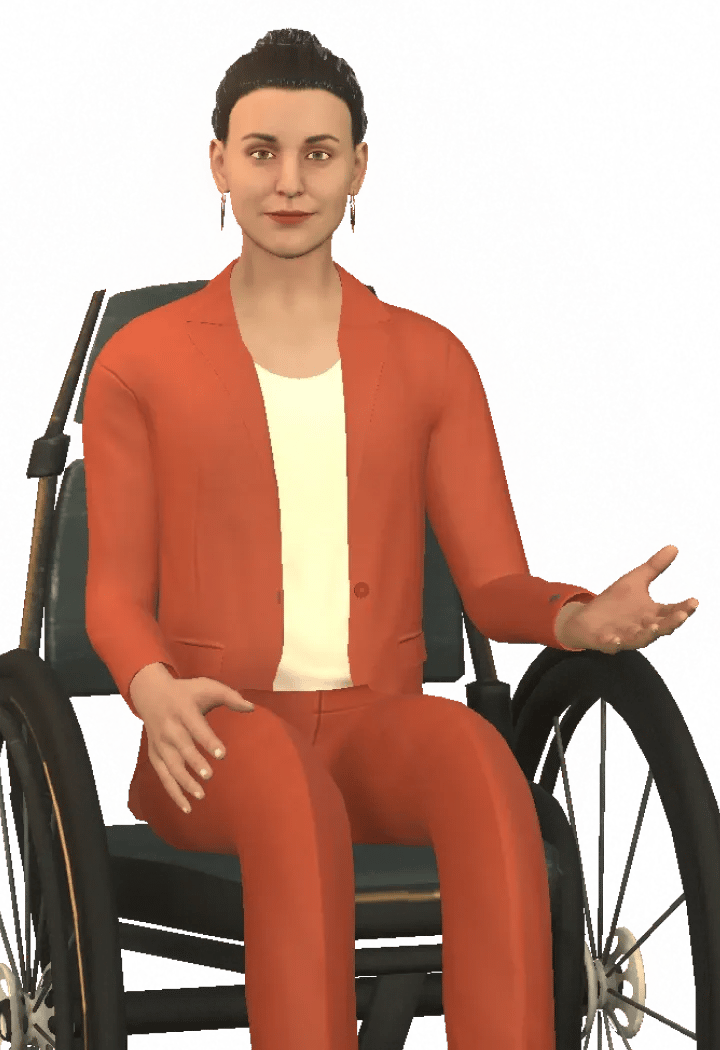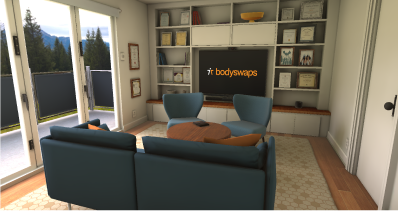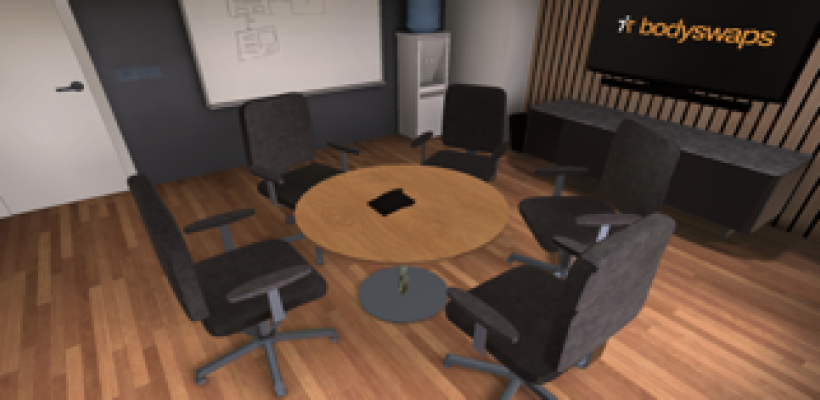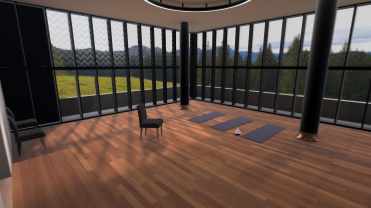Job interview simulator
Tutor notes
Honing your interview technique takes practise. But getting that practise in with real interviews takes time, which could mean missed opportunities and a long job hunting journey. If you can gain that valuable practise beforehand, you’ll enter interviews feeling more prepared and confident, and increase your job prospects.
This Job Interview Simulator module allows learners to practise answering a broad range of interview questions in a safe space, where they’ll receive useful hints and tips, be free to make mistakes, and can keep refining their approach.
About this resource
Key learner outcome and goals
Learning outcome
Learn how to effectively sell yourself to interviewers.
Learning goals
- Fine tune your interview technique and put your skills to the test.
A word about terminology
As a medium, Virtual Reality is not best suited to didactic teaching methods.
However, our intention is that all Bodyswaps modules follow a student-centred constructivist pedagogy. This means creating rich experiences in which learners can explore key concepts and ideas and reach their own conclusions.
This is why our documents speak in terms of learning goals and outcomes, rather than measurable ‘learning objectives’ (a la Bloom’s Taxonomy) per se.
Module structure
The focus of this module is the simulation, giving the learner an opportunity to practise answering interview questions as much as they like. It is bookended by ancillary activities such as onboarding, self-reflection, and the exit survey.
It is estimated that the module will take the learner approximately 15 minutes to complete, although completion time will vary depending on how many questions they choose to practise, and if they choose to fine-tune their responses.
Learner journey
.svg)
.svg)
.svg)
.svg)
.svg)
.svg)
Characters
.webp?width=720&height=1050&name=abeeku%20(1).webp)

Ashley
Virtual coach.webp?width=720&height=1050&name=tula%20(2).webp)
Tula
Wellness coach (optional)
Florence
Virtual interviewer
Jeremy
Virtual interviewerEnvironments

Tutor room - Bodyswaps HQ

Meeting room

Meditation space
The 5Cs of interview questions
Interview questions tend to fall into five different categories, which we call the 5Cs:
-
Classic questions - those common questions that come up in nearly every interview
-
Career goal questions - professional achievements and aspirations
-
Character questions - who you are, your morals, integrity and values
-
Competency questions - evidencing your ability to do the job
-
Curveball or creative questions - designed to put you on the spot
Before you test your wits in Module 4’s interview simulation, dedicate at least 5 minutes to thinking about the types of questions you feel most and least equipped to answer. This insight will help you decide which mode of play to select.
The simulation will provide hints and guidance on best - and worst - practice for every question you answer.
Purpose
Familiarise the learner with the Bodyswaps environment and prepare them for the experience to come
Location
Characters
Ashley and Abeeku
Duration
The first time learners use Bodyswaps, an onboarding sequence familiarises them with the features of the app, takes them through an avatar selection and embodiment activity, and prepares them for the experience to come.
In the onboarding, learners will:
- Find out how this training is different from the rest
- Select their avatar
- Discover their virtual journal
- Learn how to navigate and use the tools and settings
Purpose
Introduce the module and reflect on current confidence levels before beginning the activities
Location
Characters
Duration
The module begins with Ashley and Abeeku preparing the learner for the upcoming simulation, where they’ll get to answer as many questions as they like from six different categories. Each interaction in the simulation will follow a five-step flow:
- Choose your category
- Listen to the question
- Deliver your answer
- Bodyswap
- Analytics and feedback
Before proceeding, the learner answers how confident they feel about their job interview skills on a scale of 1 to 5, which will be repeated in the debrief at the end, to assess how their confidence levels have changed.
The coaches also invite them to take an optional anxiety-calming session with their meditation coach, Tula, if they wish, before the learner heads over to the meeting room.
Note: If you wish to receive data about how the learner’s confidence levels have changed as a consequence of the training, It is important that they complete this introduction and the debrief at the end.
Purpose
Manage anxiety using power pose, visualisation and mindful breathing
Location
Meditation space
Characters
Tula
Duration
When we feel anxiety or negative thoughts coming on before interviews, it’s useful for us to turn our attention to what we’re doing with our body. Adjusting our posture and breathing is an easy, effective way to combat nerves.
For this optional activity, the learner heads over to Tula’s meditation space to try out some practical, science-backed activities for physically dispelling anxiety.
The first technique that Tula guides the learner through is power posing. This involves adjusting their posture to straighten their body and take up more space. Scientific research shows us that occupying this pose for just two minutes significantly reduces the stress hormone cortisol.
While adopting their power pose, the learner also practises controlled breathing, combined with grounding and visualisation techniques that help them to feel immersed in the mindful state.
Purpose
Practise answering interview questions
Location
Meeting room
Characters
Florence or Jeremy (Learners Choice)
Journal
Duration
The learner starts by choosing which virtual interviewer they’d like to practise with – Florence or Jeremy – who ask whether they’d like to use the C.A.R (Context, Action, Result) or S.T.A.R. (Situation, Task, Action, Result) framework to structure their response. Once the learner has chosen, the interviewer invites them to choose a questions category:
- Classic
- Career goals
- Character questions
- Competency questions
- Curveball or creative questions
- Combination of all categories
- Role-based questions
Florence or Jeremy ask a question from the chosen category at random, and the learner then responds in their own words. There is no time limit to their answer, and they can practise with as many questions from as many categories as they like.
After each response, they’ll bodyswap with Florence or Jeremy and listen back to it. Hints for that question will appear on the screen behind their avatar as they listen.
Once they’ve bodyswapped back into their avatar, they’ll receive AI-enabled feedback about their speaking pace, filler words, hand gestures, and eye contact, to help them refine their technique. They can also access an AI-enabled personalised analysis of how they could improve the content of their response (which also includes analysis of their use of the C.A.R. or S.T.A.R. technique), as well as an AI-generated model answer. They’re then invited to answer the same question again if they wish, or move onto another one.
Hints from the screen and additional guidance about applying their chosen structured technique to the questions they answered will go into their journal.
When they’re ready to finish answering questions, the learner heads back to the tutor room with Ashley and Abeeku for a debrief.
Purpose
Practise answering interview questions
Location
Meeting room
Characters
Florence or Jeremy (Learners Choice)
Duration
There are 12 questions in each category. Examples include:
- Classic
What are your strengths?
What are your hobbies? - Career goals
Where do you see yourself in 5 years?
What is your dream job? - Character questions
What are your core values?
Tell me something about you that isn’t on your CV - Competency questions
Tell me about a big change you’ve had to deal with
Tell me about a time you were working under pressure - Curveball or creative questions
Would you rather be liked or feared?
If you were an animal, what would you be? - Combination of all categories
Asks a question at random from any of the categories
Role-based questions work slightly differently: the learner speaks aloud the name of the role they’d like to apply for, and AI generates a series of questions for Florence or Jeremy to ask that are relevant to that role. It also generates the guidance text and model answer supplied with the feedback after each question.
Note: You can pre-select the questions you’d like the learner to be asked via Bodyswaps Go, if you wish.
Purpose
Debrief the learner upon completion of the training and prompt self-reflection
Location
Tutor room
Characters
Abeeku and Ashley
Finally the learner is invited to answer the same question from the start, about how confident they feel about their job interview skills on a scale of 1 to 5, to see if their confidence levels have changed.
Purpose
Assess the effectiveness of the training itself
Location
Characters
Florence or Jeremy (Learners Choice)
Duration
Before the learner leaves the module, they are asked to complete a short survey about their experience.
This survey is not compulsory, but the data helps us to assess the effectiveness of our product and identify any areas that need improvement. Clients also find it beneficial when assessing ROI.
They are asked to mark whether they agree or disagree with the following statements, on a 10 point scale:
- I would recommend this experience to others.
- The experience helped me identify elements I could improve upon.
- I now have a better understanding of how to manage interview anxiety.
That’s a tricky one!
Make a note of any interview questions from the simulation that you found especially difficult. Bearing in mind the hints and guidance from the simulation, try to think of how you would answer it now, using the C.A.R. technique and then perform your answer in front of the mirror.
Remember, these are some of the best tried and trusted interview techniques used by expert careers counsellors. You’ve got this!
Best of luck with your next interview!
